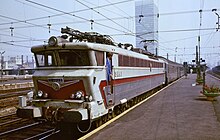Paul Arzens
Paul Arzens ( 1903 - 1990 ) was a French designer . He became known for the locomotives and trains he designed. For decades it was the preferred designer and color designer of the French state railway SNCF . In addition to his design work, Paul Arzens painted in the classical style and created sculptures.
plant
Rail vehicles
His design office in Paris' Rue de Vaugirard began to influence the large series of locomotives BB 9200 , BB 16000 and BB 25200 from 1957 . Arzens designed the X 4200 observation railcar with a panoramic view and the bodies of the BB 67000 and A1AA1A 68000 series .
The design of the CC 40100 called “ Nez cassés ” (“broken noses”) , in which he was inspired by the sight of a sprinter on the starting block, became the model for a whole generation of locomotives: CC 72000 , CC 6500 , CC 21000 to BB 15000 and finally BB 7200 and BB 22200 as well as (but without the dynamic multi-colored SNCF paintwork) the Dutch series 1600 and 1700 built in France , the Portuguese series 2600 and the Moroccan series E1300 . With the Korail series 8000 , the design also came to the South Korean Railways Korail .
SNCF BB 15000 (1971), 2005 in Paris-Est station
SNCF BB 22200 (1976) in the Laroche - Migennes depot
NS 1600 (1981), 2013 at DB Schenker
Korail 8000 (1986) in 2012
In addition to SNCF, the Parisian public transport company RATP , for which he designed several metro stations , became his customer.
Automobiles
At the time of the emerging streamlined vehicles , his two futuristic automobile studies also caused a stir . First he created “La Baleine” (The Whale) in 1938, an approximately seven-meter-long convertible on the chassis of a Buick from 1928 with 3500 cm³ displacement and 68 hp from six cylinders . This allowed the vehicle to reach a speed of around 160 km / h, whereas the Buick with the original body only reached 110 km / h.
The concept vehicle “ L'uf électrique ” (The Electric Egg) followed in 1942 , a construction made of aluminum and Plexiglas . At first it was operated electrically with five 12 volt batteries with 250 Ah each , after the Second World War with a 125 cm³ single cylinder engine. The car could be used in city traffic with a speed of up to 80 km / h.
In 1951, Arzens manufactured a small car called the “Carrosse”, but it remained a prototype . Here a rear engine with a displacement of 125 cm³ provided the drive. The maximum speed was given as 72 km / h.
Paul Arzens drove the first two cars until his death. The two cars are shown today in the Mulhouse Automobile Museum ( Cité de l'Automobile ):
literature
- George Nick Georgano (Editor-in-Chief): The Beaulieu Encyclopedia of the Automobile. Volume 1: A – F. Fitzroy Dearborn Publishers, Chicago 2001, ISBN 1-57958-293-1 . (English)
Web links
- Image by Paul Arzens on Ferropedia, Spain
- Short biography on the European Route of Industrial Heritage page
- thumb of a picture by Paul Arzens at Artnet
Individual evidence
- ↑ http://www.3wheelers.com/arzens.html
- ^ Georgano: The Beaulieu Encyclopedia of the Automobile.
| personal data | |
|---|---|
| SURNAME | Arzens, Paul |
| BRIEF DESCRIPTION | French designer |
| DATE OF BIRTH | 1903 |
| DATE OF DEATH | 1990 |











